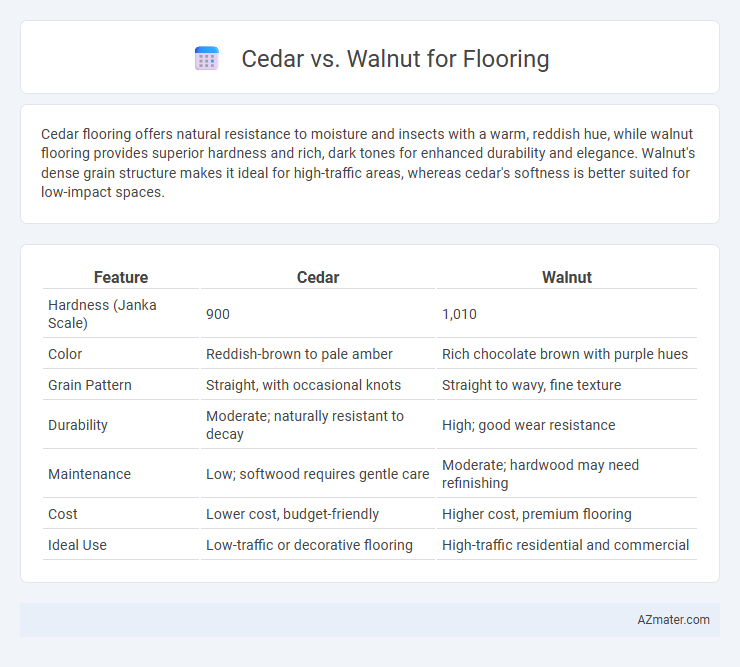Cedar flooring offers natural resistance to moisture and insects with a warm, reddish hue, while walnut flooring provides superior hardness and rich, dark tones for enhanced durability and elegance. Walnut's dense grain structure makes it ideal for high-traffic areas, whereas cedar's softness is better suited for low-impact spaces.
Table of Comparison
| Feature | Cedar | Walnut |
|---|---|---|
| Hardness (Janka Scale) | 900 | 1,010 |
| Color | Reddish-brown to pale amber | Rich chocolate brown with purple hues |
| Grain Pattern | Straight, with occasional knots | Straight to wavy, fine texture |
| Durability | Moderate; naturally resistant to decay | High; good wear resistance |
| Maintenance | Low; softwood requires gentle care | Moderate; hardwood may need refinishing |
| Cost | Lower cost, budget-friendly | Higher cost, premium flooring |
| Ideal Use | Low-traffic or decorative flooring | High-traffic residential and commercial |
Introduction to Cedar and Walnut Flooring
Cedar flooring offers a warm, reddish-brown hue with natural oils that provide resistance to moisture and insects, making it ideal for humidity-prone areas. Walnut flooring features rich, dark tones with a smooth grain pattern, prized for its durability and luxurious aesthetic in high-end interiors. Both woods bring unique qualities to flooring choices, with cedar emphasizing resilience and aroma, while walnut highlights elegance and strength.
Key Characteristics of Cedar Wood Flooring
Cedar wood flooring is prized for its rich reddish hues, natural resistance to decay, and excellent dimensional stability, making it ideal for humid environments. Its soft texture provides a warm, comfortable underfoot feel, while its aromatic oils help repel insects and enhance indoor air quality. Compared to walnut, cedar tends to be lighter and softer, offering superior thermal insulation and a more rustic, natural aesthetic.
Essential Features of Walnut Wood Flooring
Walnut wood flooring is prized for its rich, dark brown hues and fine, straight grain, offering a luxurious and timeless aesthetic. Its high durability and hardness rating of 1010 on the Janka scale ensure excellent resistance to wear and dents, making it ideal for high-traffic areas. Walnut's natural dimensional stability minimizes warping and shrinkage, providing long-lasting, low-maintenance flooring.
Durability Comparison: Cedar vs Walnut
Walnut flooring offers exceptional durability with a Janka hardness rating of approximately 1,010, making it highly resistant to dents and scratches compared to cedar, which has a lower Janka hardness of around 350. Cedar's softness makes it more prone to surface damage and wear, but it provides natural resistance to moisture and insect damage, which can enhance its longevity in certain environments. Choosing between cedar and walnut for flooring depends on balancing walnut's superior durability and hardness against cedar's natural resilience and softer aesthetic.
Visual Appeal and Color Differences
Cedar flooring boasts a warm, reddish hue with natural knots and grain patterns that create a rustic and cozy aesthetic, while walnut offers a rich, dark brown color with subtle purple undertones and a smooth, fine grain that exudes elegance and sophistication. Cedar's lighter tones often brighten interiors and complement casual or traditional designs, whereas walnut's deeper shades enhance modern, formal, or luxurious spaces. The visual appeal of cedar leans towards a vibrant, textured character, whereas walnut provides a sleek, uniform look with a timeless quality.
Cost and Affordability Analysis
Cedar flooring typically costs between $4 to $7 per square foot, offering an affordable option with natural resistance to moisture and insects, making it ideal for budget-conscious homeowners seeking durability. Walnut flooring, priced at approximately $8 to $14 per square foot, represents a higher-end investment due to its rich color, hardness, and distinctive grain patterns, often favored for luxury interiors. Considering long-term value, cedar provides cost savings with easier maintenance, while walnut's premium price reflects its aesthetic appeal and longevity in high-traffic areas.
Ease of Installation and Maintenance
Cedar flooring is softer and lighter, making it easier to cut and install compared to the denser walnut, which requires more effort and specialized tools for precise handling. Maintenance of cedar involves regular sealing to prevent dents and moisture damage due to its softer surface, while walnut's natural hardness provides better resistance to wear and requires less frequent refinishing. Both woods need periodic cleaning and protective finishes, but walnut's durability offers a longer-lasting, lower-maintenance option for flooring.
Environmental Impact and Sustainability
Cedar flooring offers a renewable resource due to its fast growth rate and ability to be harvested sustainably, often sourced from responsibly managed forests with certifications like FSC. Walnut, while prized for durability and rich color, grows more slowly and typically requires longer harvest cycles, which can impact forest regeneration rates negatively if not managed properly. Choosing cedar can reduce carbon footprint and promote biodiversity, whereas walnut's higher density and longer lifespan may offset its initial environmental cost through durability and reduced replacement frequency.
Best Applications and Room Suitability
Cedar flooring excels in moisture-prone spaces like bathrooms and basements due to its natural resistance to decay and pleasant aroma, making it ideal for cozy, climate-sensitive rooms. Walnut offers superior hardness and deep, rich tones perfect for high-traffic areas such as living rooms and hallways, providing a luxurious, durable surface. Choosing between cedar and walnut depends on room humidity levels and foot traffic intensity, optimizing longevity and aesthetic appeal.
Final Verdict: Choosing Between Cedar and Walnut for Your Floors
Walnut flooring offers a rich, dark tone with excellent durability and resistance to wear, making it ideal for high-traffic areas and elegant interiors. Cedar floors provide a lighter, warm reddish hue with natural resistance to moisture and insects, suited for cozy, rustic environments but require more maintenance. Choosing between cedar and walnut depends on balancing aesthetic preferences with durability needs and environmental conditions of your space.

Infographic: Cedar vs Walnut for Flooring
 azmater.com
azmater.com